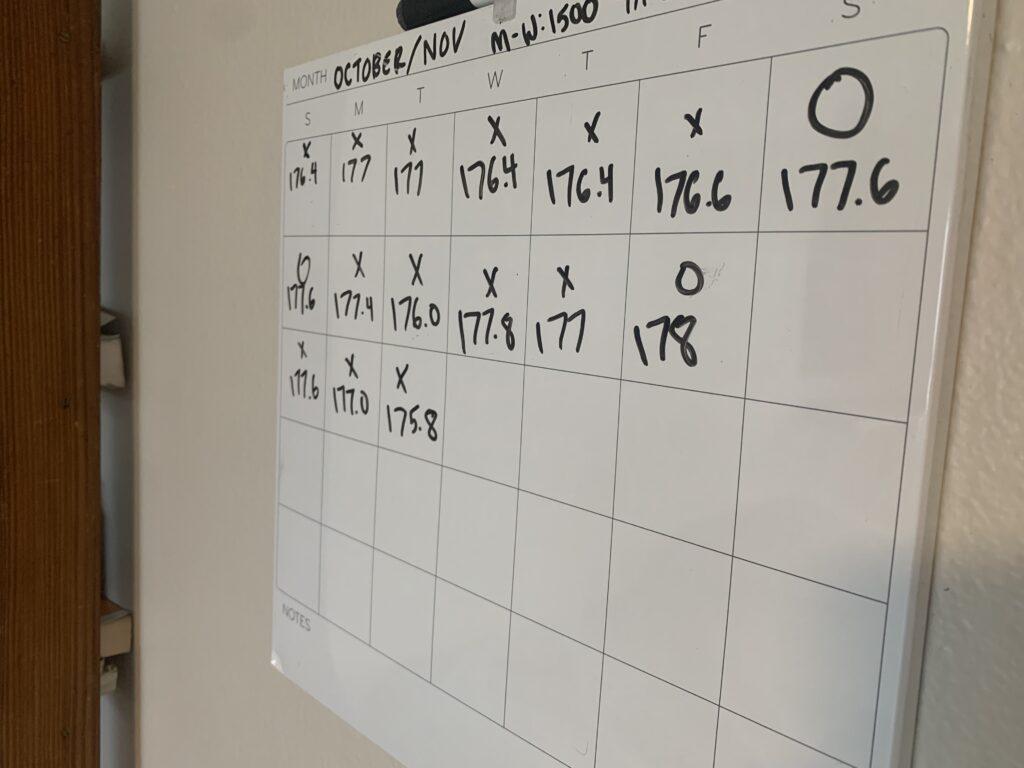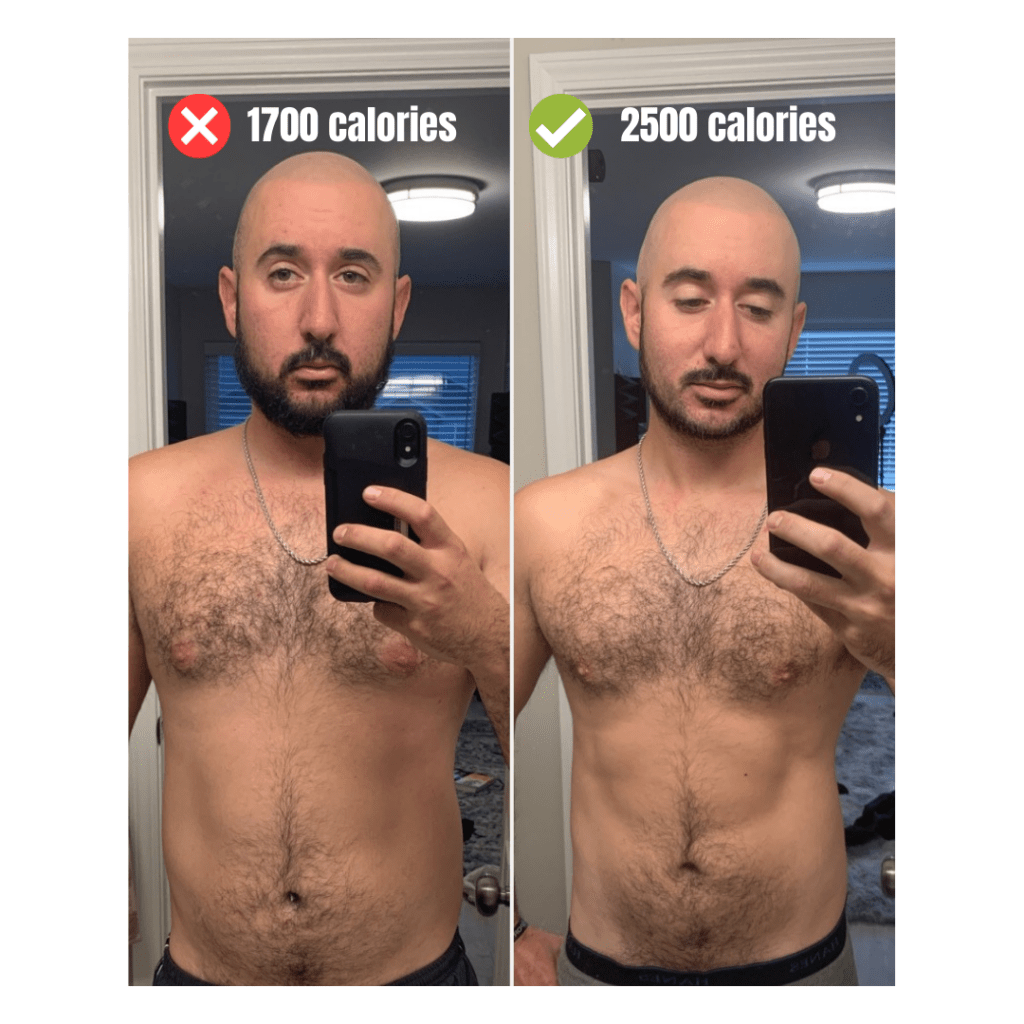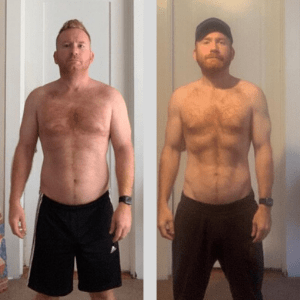There are several reasons why you may want to take a diet break…I am going to teach you how to diet break for fat loss. Pay close attention.
In this article:
- What is a diet break?
- When to use a diet break?
- How do you use diet breaks to break through a fat loss plateau?
- How to set up a diet break?
- What is a Reverse Diet?
- How do you use a Reverse Diet to come out of a fat loss phase?
WHAT IS A DIET BREAK?
A diet break is just a period of time taking a break from your calorie deficit. This means an increase in your calories for several weeks to even months at a time to maintain progress and give yourself a much-needed mental and physiological break.
Here are a couple of scenarios in which you might want to consider taking a diet break:
- a fat loss plateau
- maintaining the results of a fat loss phase
- vacation
- replenish hunger hormones
- mental fatigue from a long dieting phase
- decreased adherence/consistency
USING DIET BREAKS TO BREAK THROUGH A FAT LOSS PLATEAU
Let’s dive into my diet break experience and how to diet break for fat loss:
Whenever I have been in a fat loss phase for around 6-8 weeks, something happens with my consistency. I no longer feel as motivated, dedicated, and everything gets kind of, well…sucky.
In order to make things less sucky, and get my head back in the game, I will usually take a diet break. I have shared this many times across social media, but if your consistency drops below 80%, your results will almost come to a complete halt.
During the beginning of this last fat loss phase, I was averaging 6 out of 7 days per week of eating in a deficit, hitting my steps and protein targets. Towards the 8th or 9th week, things started to stall out. I took a look at my consistency. I use a whiteboard calendar in order to see how I’ve been doing (I’m a visual learner).

I use the X’s and O’s system. When I nailed my calories and protein, I mark the day with an x. When I miss the mark, I mark it with an O. This is NOT my idea, even though I wish it was. Jordan Syatt is the one who taught me about this little gem.
Once I saw that I had more than 4 O’s for an entire month, I knew that I needed to improve my consistency, or I would stop seeing results.
This was when I knew it was time to implement a diet break.
You see, I wasn’t actually in a plateau, and most likely, neither are you. Chances are you just need to be more consistent.
After working with dozens of fat loss clients over the years, this is the case 99.999% of the time.
Even though I wasn’t in a plateau, I knew that taking a diet break would improve my consistency to the deficit. I took a couple of weeks off, ate at maintenance (more on this later), and then went right back into my cut.
HOW TO SET UP A DIET BREAK
This is where the word maintenance will be used a lot, but don’t be deterred. The word maintenance is inherently unsexy, and this short section will hopefully make you realize how important maintenance is for long-term fat loss results.
What is maintenance?
It is simply eating the number of calories your body needs to maintain its current weight. If you were eating 2000 calories during your fat loss phase, chances are if you eat around 2300-2500 calories, you would be at maintenance. This is not a perfect equation though, because depending on the duration of your diet, your metabolism may have adjusted downward (not much). If you want to find your exact maintenance calories without overshooting it, I will discuss Reverse Dieting a bit later on.
Why is maintenance a good thing if I still have fat to lose?
- mental break from the diet
- improved performance in the gym
- ability to EAT more (the most important one)
- improve leptin levels (the hunger hormones that controls your appetite)
By the time you are done with your maintenance phase, you will be able to jump back into your deficit and feel much more ambitious and be much more consistent.
How long should you stay in maintenance?
There are no hard-set rules about this. If you want to stay in maintenance for 2-3 weeks, that may work well in terms of a diet break. I have had some clients use maintenance for several months to get through some mentally and physically demanding periods of their life. There are no real rules about how long it should last, it just depends on your goals.
How do you find your maintenance calories?
In my diet break experience, it is usually a moving target. While I would love to give you some equation to estimate your maintenance, the chances are it’s probably going to be too high, which we don’t want. This is why I recommend a Reverse Diet. More on this below…
HOW TO MAINTAIN AFTER YOU’VE REACHED YOUR GOALS
After a long fat loss phase, you have reached your goals. Now what? Do you continue eating chicken breast and egg whites? Do you continue eating a very small portion of food just to maintain your results? No. That would be miserable.
A fat loss phase is a PHASE. It’s not forever. There has to be an exit strategy. “A diet after the diet”, if you will.
This is where a Reverse Diet comes into play. Reverse Dieting is not magic. You are not going to automatically eat more food, drop body fat, put on muscle, and look like a fitness model. It’s important to set realistic expectations from the start.
You ARE going to gain some fat (not much, if done correctly), and that’s okay. You are going to definitely gain some weight on the scale, and that’s okay.
What is a reverse diet?
A Reverse Diet is simply adding back in calories incrementally over a gradual period of time, usually with the primary goal of trying to maintain progress whilst adding minimal body fat.
IMPORTANT NOTE: Increasing calories does NOT equal fat loss. This is a common theme I’ve seen in the Instagram world in the last 3-5 years.
Lots of pictures like this:

This is a fake picture. I was not eating more calories and improving my body composition. The opposite is the truth, but I wanted to clarify this: The reason you are not losing weight is NOT that you aren’t eating enough. That is just false, and I blame social media for displaying this narrative and making it very confusing for those who want the TRUTH.
Myths of “starvation mode” only confuse people, and there is no research to back this up. Most people are drastically overeating calories, not undereating. I know, it’s one of those things you wish wasn’t true.
Where this myth came from (most likely)
People trying to take your money.
Let’s say you are in a calorie deficit, and you are eating 1200 calories per day.
Maybe your maintenance is 2200. This would mean you are in a 1,000 calorie deficit.
EXCEPT…you’re not actually eating 1200 calories. You just think you are 😉
You aren’t tracking cooking oil, sauces, miscalculations in raw vs. cooked proteins (very common, read this article for more info on this), and you are actually going off your diet on the weekends. Let’s say you are actually eating closer to 1500 calories per day, and then 2200 every Saturday…
Your Weekly Calories: 11,200
You think you hit a “plateau”, but realistically you just aren’t eating in a deficit any more.
So you hire a “Reverse Diet” expert coach. He sets up your calories like this:
- Week 1: 1250
- Week 2: 1300
- Week 3: 1350
- Week 4: 1400
- Week 5: 1450
- Week 6: 1500
You are seeing results while eating MORE food! How could this be??? Clearly, this coach is a magic fat loss magician!
Nope. You are just still in a calorie deficit, and now you have a coach to hold you accountable, so you are actually being more accurate and consistent.
Remember, your maintenance is 2200, so you will still be losing fat eating any less than that.
Not to mention when calories are increased, there will be a subconscious increase in NEAT. This means you will walk, fidget, and move more without even thinking about it, thus increasing energy expenditure (calories burned).
HOW TO USE A REVERSE DIET (THE DIET AFTER THE DIET)
Kind of like maintenance, there is no specific formula on how to set up a Reverse Diet, however, there is a general framework that many coaches use, so I’ll share it here.
This is my client Justin.

Justin finished out his cut eating around 1700 calories.
He wanted to be able to eat more food and slowly move back into maintenance, this is his diet break experience. This is how we set up his Reverse Diet:
- Week 1: 1750
- Week 2: 1800
- Week 3: 1900
- Week 4: 2000
Around week 4, we noticed some increases in his weight, and his waist measurement was increasing a tiny bit. We slowed down and continued to increase his calories.
- Week 5: 2050
- Week 6: 2100
- Week 7: 2150
- Week 8: 2200
After week 8, we saw many fluctuations in Justin’s weight, but his waist measurement was staying the same. This told us that he was not gaining fat. He was definitely gaining some water weight, muscle glycogen, and maybe even some muscle at this point, but not fat. It’s important to remember that waist measurement is a great indicator of fat gain/loss. We decided to keep going, as we still did not see any real changes in his progress photos and he was eating quite a bit more food!
- Week 9: 2250
- Week 10: 2350
- Week 11: 2450
- Week 12: 2500
Around this point, Justin was totally happy with the amount of food he was eating at this point. His training was progressing nicely, and he was loving the amount of energy he had in the gym. If he wanted to gain some muscle at this point, he could keep adding calories back in to get him to a 100-200 calorie surplus, which would be optimal for muscle building, or he could just maintain from here at 2500.
WRAPPING UP: How to diet break for fat loss
- Use a diet break when you are plateaued, or have reached your goals. Some coaches implement them every 8-10 weeks.
- Instead of just guessing your maintenance calories, use a Reverse Diet to slowly bring calories up over a period of time to make sure you don’t overshoot and gain unnecessary fat.
- Be patient with the process, use photos, measurements, and scale data to assess your goals.
- When all else fails, hire a coach to help you along the way.
Hope this article was informative, drop any questions below, and if you want me to coach you, you can apply for coaching here.
-JP

